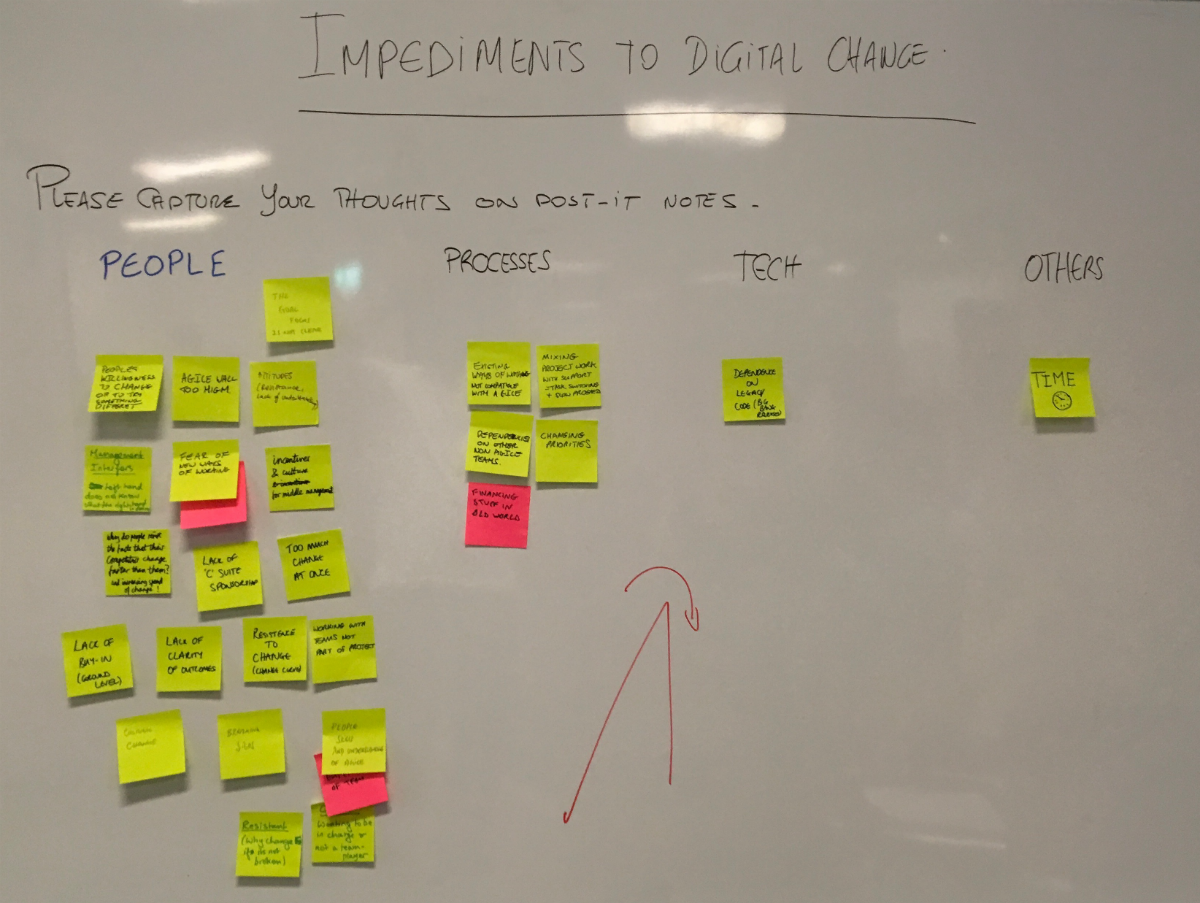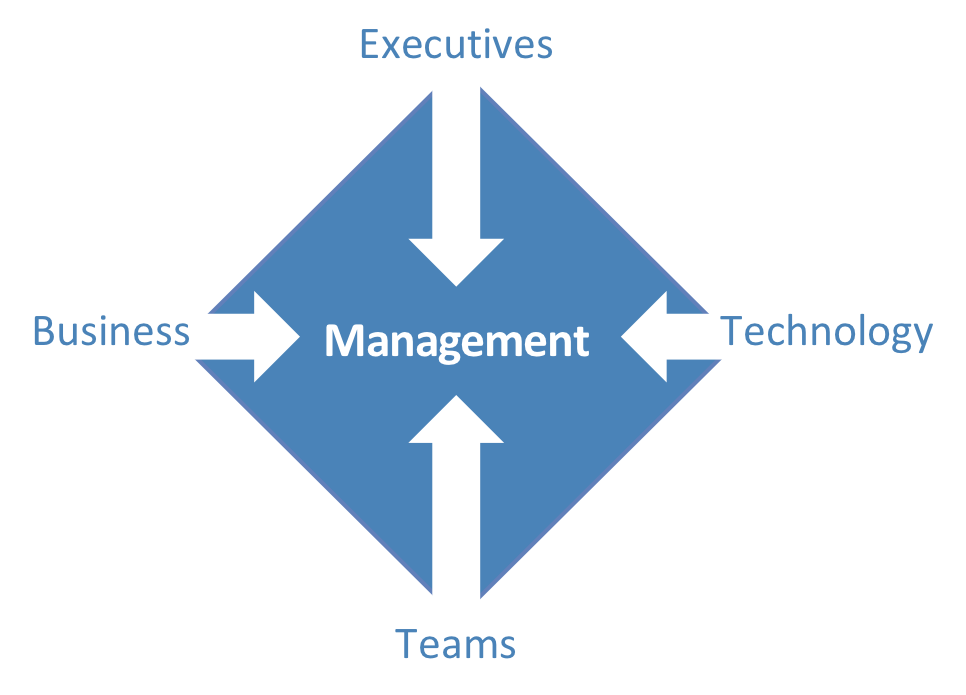You will have seen many times this quote from Steve Jobs: “It does not make sense to hire smart people and tell them what to do; we hire smart people so they can tell us what to do.” This quote probably resonates, even more today, when most enterprises are facing the complexity of adapting to digital change and progressing towards agility.
Have we truly changed our management style to embrace such wise words however? Do we even understand where to start to leverage the collective intelligence of the teams, or does this remain rhetoric for conferences?
It is my experience that many digital change and agile adoption efforts start by falling short of expectations before somebody decides to recalibrate the approach.
Have you also lived through this, or is it just me? The CIO said: “Next year we will be 80% agile.” The focus then goes on wholesale adoption. Such an approach ends up packaging codified processes and practices (call it Scrum or SAFe) and rolling them out throughout the organisation. Change is inflicted on the teams by external specialists, with a view of achieving the 80% target within the year. Sure enough, within some time, Scrum starts becoming the norm. However, how does it matter? Scrum on its own achieves very little. It does not deliver the digital competitiveness that motivated the effort in the first instance. More worryingly the operation ends up held together by coaches and consultants, that have become part of the structure. It is as if you kept the scaffolding on an edifice after the construction. Then start the cynical voices, “told you, agile does not work for our core enterprise environment”. It can even descend into a religious debate between the traditionalists, the agilists-like-this and the agilists-like-that.
At our last Digital Leadership Meetup, we asked the participants what the most significant impediments to digital change and agile adoption were. They captured their answers on post-its. We did not reveal the categories up-front so not to biased this small empiric test.

Result of a small empiric evidence at our last meetup, impediments to Digital change and agility
Answers speak for themselves. Most challenges were about People and Leadership. It dwarfed Processes and Technology by a long way. That said, most of the transformation investments go into implementing processes and technology because businesses need something tangible to put their money on. Such situations are not new. Many moons ago, Lean adoption in manufacturing and services suffered the same debacles and resulted in the same stigmas. Some did succeed though, and likewise, some did get agile and digital right. The ones that did get digital change right seem to operate a magic formula leveraging the intelligence of their teams. They found a way to implement the words of Steve Jobs.
The challenge of digital change is one of alignment

- Product alignment: Horizontal alignment across business and technology. The product alignment consists in taking a view of value and flow and reorient the organisation accordingly. We will cover this alignment in a future article.
- System alignment: Vertical alignment from executives to teams. The system alignment involves what I would call the systemic elevators. The downstream elevator cascades the strategy. The upstream elevator raises the visibility of the systemic challenges through continuous improvements. We will also cover the systemic elevators in a future write up.
Management are at the centre of this orthogonal alignment and in many cases, they have been frozen out of the change effort. They are mocked for their resistance to change. I did hear the term of “middle-management Permafrost”. Should we be that surprised? Have we trained them to manage in this new world? How often did we invite them to cascade the strategy? Have we built a channel for resolving systemic constraints? MITSloan published a shocking article on this topic. One company revealed how 97% of their senior leadership indicated that they had a clear understanding of the company’s priorities in the annual engagement survey. However, when questioning those same managers with some fuzzy logic to check their recollection of the company’s strategic objectives, only 25% could list 3 out of 5 of the key priorities. One-third of the leaders could not even mention one! Not surprisingly, those figures drop sharply when cascading the questions further into the teams. That organisation was not an exception, the same survey across 124 organisations revealed that only 28% of senior and middle managers could list 3 out of the 5 strategic objectives. No matter how many times the strategy gets explained, one-way communication only goes so far. Involving the system of people, as per the words of Steve Jobs, ensures understanding, buy-in, engagement and ownership of delivering the strategy.
Systemic management
Systemic management goes beyond the standard approaches of looking at the emotional intelligence of the individual or the social intelligence of the individual with the group. Systemic management operates at the system relationship intelligence level. It works with the whole group. Alignment is at the heart of systemic management. It is consequently beneficial in periods of change. People systems are at an edge, tensions and change resistance occur, individualities emerge, conflict often results.
Teams, as systems of people, are naturally intelligent and creative. The role of the leaders is to unleash this potential.
Systemic management offers education, principles and tools to handle changing situations and create positivity in the teams and across the organisation. It provides many applications from designing the system of the team and its alignment to a charter to understanding toxic behaviours and how to create a positive atmosphere, handling conflicts, overcoming change edges, distributing roles effectively, connecting with the essence of the business to drive innovation, etc.
As change is becoming a constant feature of most businesses, systemic management is a quality that every manager should learn and master. It is not new. It has existed for some time in the form of systemic coaching, and it is now coming to the agile adoption and digital transformation worlds.
How we may help and how you can benefit
I have completed the lengthy training process for systemic coaching using ORSC (Organisation and Relationship System Coaching). I am now moving to the equally demanding certification process. Please note that there are only a handful of certified ORSC digital agilists globally; this is a rare skill set.
In support of this process, I am looking to secure some client “systems” to work with. There are two options for intervention:
- Pure systemic coaching of a team or a leader
- Mixed systemic coaching with digital and agile change strategy
Systemic coaching works with leaders managing their organisation, teams, partnerships, boards, SteerCos and even married couples. So, the applications are broad and varied.
I would consider some pro-bono work for particular interventions. I would offer substantially discounted rates for the first two clients, and cut fees for the next two, for work in support of the certification process. This offer is on a first come first served basis and needs to be in place by September.
Please get in touch if this is of interest.
Sources:
MIT Sloan: New research reveals the surprising reasons managers don’t know their company’s strategy
Bob Emiliani, Speed Leadership and The triumph of Classical Management over Lean Management.
ORSC, Organisation and Relationship System Coaching. Please see www.CRRUK.com

